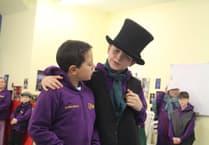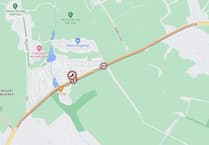Food & Farming visited Paula and Danny Creer who are in the thick of lambing their pedigree Texels at Ballaglonney in Marown.
The ewes who are still to lamb are in the ‘ante natal unit’ in a big shed. When they lamb, they are then moved with their lambs to single pens at one end of a huge polytunnel.
Danny says: ‘We got them all in the night before the snow. The Met Office did a really good job for giving us a bit of warning about the snow – they deserve the credit for that.’
The first crucial thing they have to do after a lamb is born is to make sure it is sucking well on its mother and getting that vital first colostrum.
‘It’s amazing how much time you spend getting them going,’ says Paula.
As with all farms, where there are orphan lambs, or lambs that are not suckling properly, it usually means four-hourly bottling feeding by hand for the first few weeks. But the Creers recently bought a machine that mixes the milk powder and delivers the milk to the lambs via a rubber teat, at just the right temperature, as and when they are hungry.
They currently have five lambs using the machine, although Paula says that they try and adopt on and usually only have around eight in total over the lambing season being fed this way.
Once the lamb’s feeding is established, after four or five days they are put into larger pens with other ewes and lambs at the other end of the polytunnel, to give them a chance to socialise before they are all turned out into the fields.
Lambing takes place at Ballaglonney, in Crosby, but Paula and Danny live at Coolingel Farm, just up the road, which mean Danny making frequent visits to Ballaglonney through the night in case any of the ewes are in difficulties lambing.
The history of the family running the two farms goes back to Danny’s great grandfather who had the tenancy at Coolingel. When he died, his son Dan, Danny’s grandfather, was not yet 21, the age he needed to be to take over the lease. ‘So they had to sell the stock and give up the tenancy,’ says Danny.
Dan did, however, get the tenancy back, around 16 years later. Then, in 1960, Dan bought Ballaglonney and in 1974, Danny’s father, Colin, bought Coolingel.
Danny and Paula have the help of Stephen Sloane with the lambing as well as various members of their family: sons Dan, Tom and Finn, daughter, Aalish, and Dan’s partner, Alice.
‘Everybody just pulls in and does what’s required – Alice is great to come and help out,’ says Paula.
After the pedigree Texels are finished they move on to the commercial sheep lambing. They have also just started calving their herd of Charolais, Limousins and Stabilisers.
Paula says that when she and Danny were first married they were lambing in January, but it has grown later as the years have gone by.
She says: ‘We started lambing later this year because of difficulties getting hold of the right genetics because we are always looking to improve our stock.’
Following the 2001 Foot and Mouth outbreak in the UK, strict regulations regarding the movement of sheep has meant a period of isolation for tups before they can travel to the island and then 10 more days of post import isolation before they can be used on the ewes.
‘It causes a lot of delay in your breeding programme,’ says Paula.
The Creers used six tups this year. Their two Royal Show Supreme Champions, Cotton Eye Joe who stood Supreme Champion at the Royal Show in 2021, and Corris Dundee who won both the Royal and the Southern Show Supreme champion titles last year.
They also bought a tup, Honacott Easy on the Eye, from Devon and used three others: Corris Escobar, from the same flock as Dundee, who was male champion at the Royal Welsh Show; Heart Right Extreme, from Worcestershire, and Carreria Diamond.
So with lambs with these pedigrees coming through, how soon will they start picking out more future champions?
Paula laughs and says: ‘We try not to pick a favourite because something always goes wrong when we do!’




